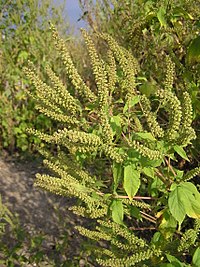
Photo from wikipedia
Abstract Mugwort (Artemisia vulgaris) and ragweed (Ambrosia artemisiifolia) are highly allergenic Asteraceae. They often cause pollen allergies in late summer and fall. While mugwort is native to Europe, ragweed reached… Click to show full abstract
Abstract Mugwort (Artemisia vulgaris) and ragweed (Ambrosia artemisiifolia) are highly allergenic Asteraceae. They often cause pollen allergies in late summer and fall. While mugwort is native to Europe, ragweed reached Europe as a neophyte from North America about 150 years ago and continued spreading ever since. To understand possible relationships between the spread of ragweed, its abundance in air, and to judge possible health risks for the public, we quantified ragweed DNA in inhalable fine as well as in coarse air particulate matter. Mugwort was chosen for comparison, as it is closely related to ragweed and grows in similar, though mainly not identical, habitats but is native to Germany. The DNA quantification was performed on atmospheric aerosol samples collected over a period of 5 years in central Europe. The DNA concentrations were highest during the characteristic pollination periods but varied greatly between different years. In the inhalable fine particle fraction, ragweed exceeds the mugwort DNA concentration fivefold, while the coarse particle fraction, bearing intact pollen grains, contains more mugwort than ragweed DNA. The higher allergenic potential of ragweed might be linked to the humidity or long-range transport-induced bursting of ragweed pollen into smaller allergenic particles, which may reach the lower airways and cause more intense allergic reactions. Airborne ragweed DNA was detected also outside the local pollination periods, which can be explained by atmospheric long-range transport. Back-trajectory analyses indicate that the air masses containing ragweed DNA during winter had originated in regions with milder climate and large ragweed populations (Southern France, Carpathian Basin).
Journal Title: Aerobiologia
Year Published: 2017
Link to full text (if available)
Share on Social Media: Sign Up to like & get
recommendations!